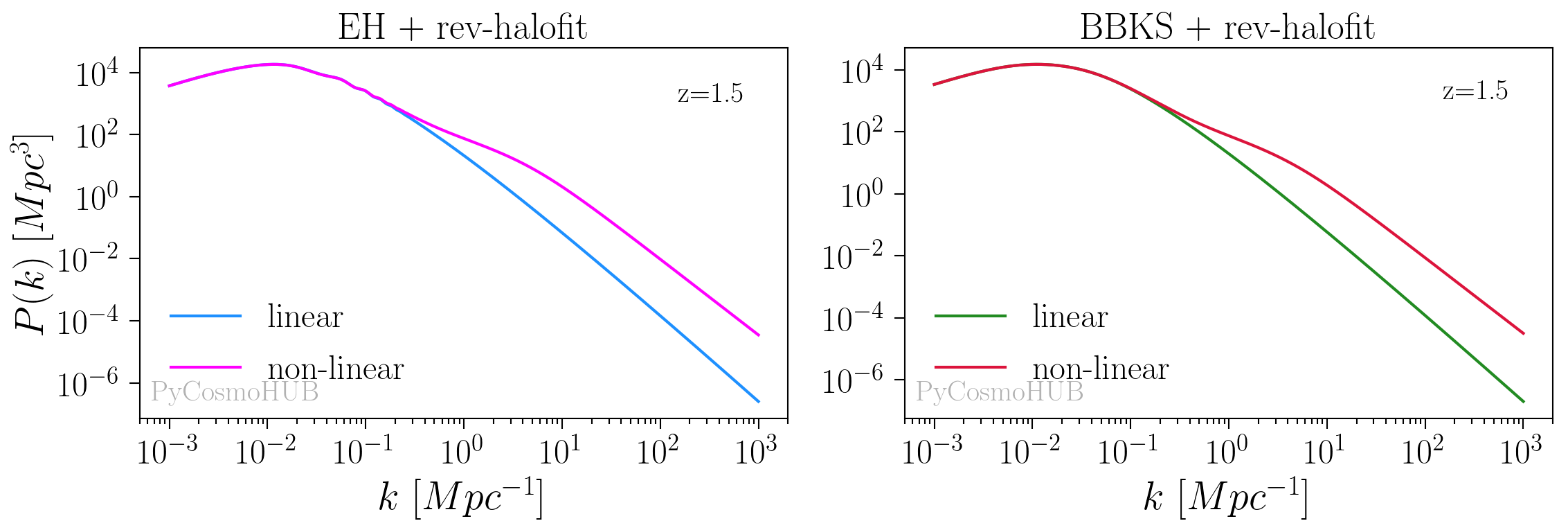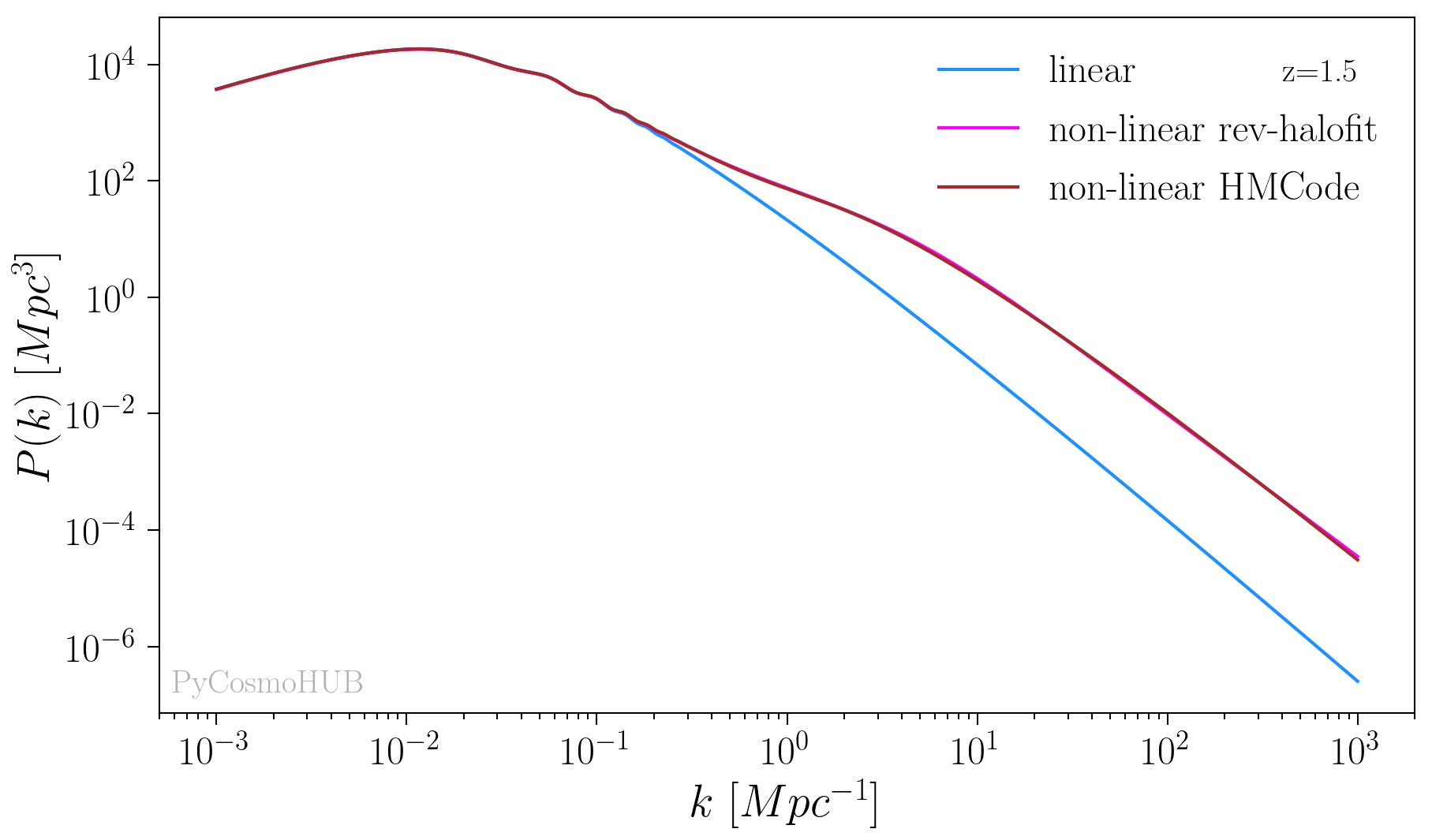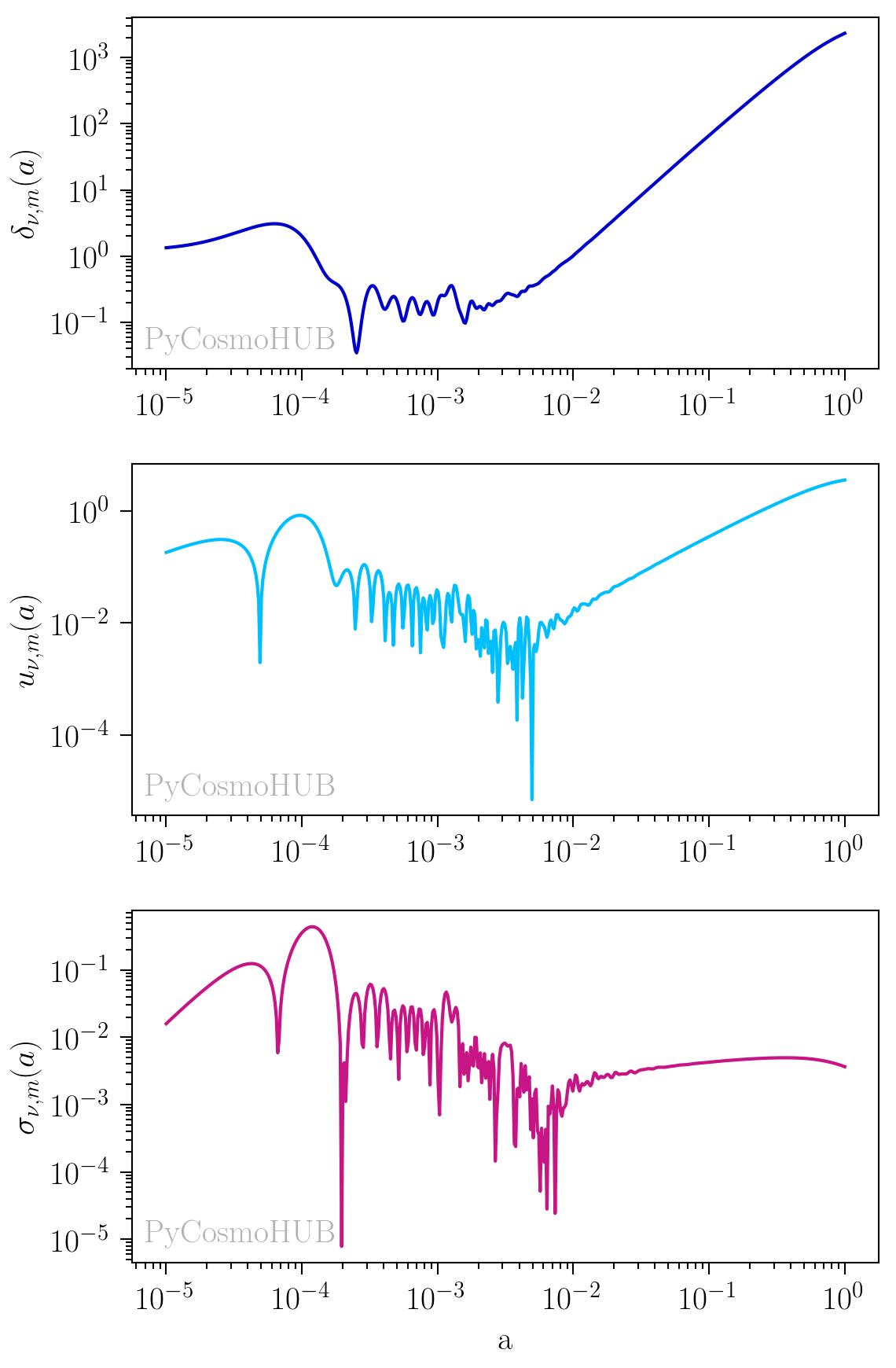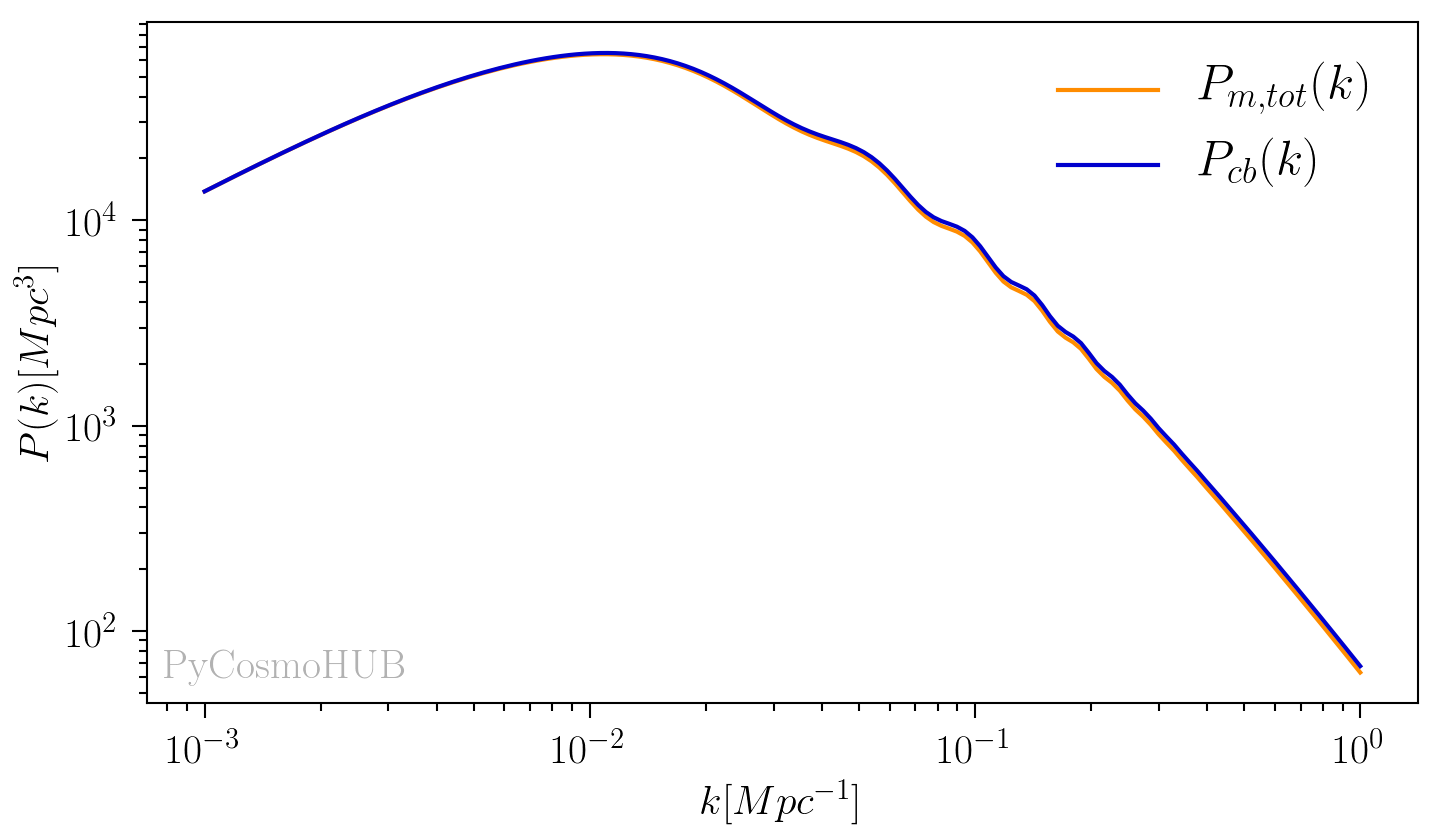Usage¶
To run the current version of PyCosmo:
Launch python
Import PyCosmo:
>>> import PyCosmo
Create an instance of the Cosmo class:
>>> cosmo = PyCosmo.build()
This is the class that is used to manage the cosmology calculations. If no specific model is specified, then “lcdm” will be assumed. Else, one should specify a model as
>>> cosmo = PyCosmo.build("wcdm")
Warning
The first time you run PyCosmo.build the C packages gsl and libf2c will be downloaded and compiled in a cache folder. This will take a couple of minutes!
PyCosmo.build also takes into account parameters that determine the size and content of the ODE system, e.g.,
>>> cosmo = PyCosmo.build("mnulcdm", mnu_relerr=1e-4, rsa=True)
A complete list of the parameters that can be passed to PyCosmo.build is:
model = “lcdm”, “wcdm” or “mnulcdm”
rsa = set to True to use the radiation streaming approximation, default is False
l_max = hierarchy truncation of the radiation fields
l_max_mnu = hierarchy truncation of massive neutrinos (only for “mnulcdm” model)
mnu_relerr = relative error for the massive neutrino integration (only for “mnulcdm” model)
compilation_flags = “-0n” flags controlling level of optimization
splits = splits of the equation system to reduce memory consumption and time during compilation
reorder = set to True to reorder the equations to speed up code generation when splits are used
You can modify the input parameters and update the derived parameters with
>>> cosmo.set(omega_b=0.07)
Tip
A list of parameter options that can be used in the set function can be printed when no argument is passed., e.g., cosmo.set()
You can print the configuration parameters with
>>> cosmo.print_params()
Example calculations¶
Background¶
Angular diameter distance at a = 0.4:
>>> cosmo.background.dist_ang_a(a=0.4) array([ 1762.38876138])
Luminosity distance at a = 0.6 and 0.8
>>> cosmo.background.dist_lum_a(a=[0.6,0.8]) array([ 4048.4298942 , 1266.53970396])
Cosmological distances as a function of a:
>>> cosmo.background.dist_rad_a(a) # comoving radius >>> cosmo.background.dist_trans_a(a) # transverse comoving distance >>> cosmo.background.dist_ang_a(a) # angular diameter distance >>> cosmo.background.dist_lum_a(a) # luminosity distance
Image created with the PyCosmoHUB.

Linear and non-linear perturbations¶
Growth factor at a = 0.5 and 1.0:
>>> cosmo.lin_pert.growth_a(a=[.5,1.]) array([ 0.61200153, 1.])
Linear and non linear matter power spectrum at a = 1 for a grid of k values:
>>> import numpy as np >>> pk_l = cosmo.lin_pert.powerspec_a_k(a=1., k=np.logspace(-3,0)) >>> pk_nl = cosmo.nonlin_pert.powerspec_a_k(a=1., k=np.logspace(-3,0))
Linear and non linear matter power spectrum as a function of k, at redshift z=1.5. Examples are given using both Eisenstein & Hu and BBKS linear fitting functions, and the revised version of Halofit for the non-linear fitting function:
>>> # Set the non-linear fitting function >>> cosmo.set(pk_nonlin_type = 'rev_halofit')
>>> # Set the linear fitting function to EH >>> cosmo.set(pk_type = 'EH') >>> # Compute the linear and non-linear power spectra with rev_halofit+EH >>> pk_lin_EH = cosmo.lin_pert.powerspec_a_k(1./(1+z), k)[:,0] >>> pk_nonlin_EH = cosmo.nonlin_pert.powerspec_a_k(1./(1+z), k)[:,0]
>>> # Set the linear fitting function to BBKS >>> cosmo.set(pk_type = 'BBKS') >>> # # Compute the linear and non-linear power spectra with rev_halofit+BBKS >>> pk_lin_BBKS = cosmo.lin_pert.powerspec_a_k(1./(1+z), k)[:,0] >>> pk_nonlin_BBKS = cosmo.nonlin_pert.powerspec_a_k(1./(1+z), k)[:,0]
Image created with the PyCosmoHUB.

Non linear matter power spectrum computed with the Mead et al. model, at redshift z=1.5:
>>> cosmo.set(pk_type='EH', pk_nonlin_type='mead') >>> pk_nonlin_hmcode = cosmo.nonlin_pert.powerspec_a_k(1./(1+z), k)[:,0]
Image created with the PyCosmoHUB.

Perturbations with the Boltzmann solver¶
Linear perturbations can also be computed using the Boltzmann solver. In order to use the Boltzmann solver, set pk_type=”boltz”. It is also recommended to use pk_norm_type=”A_s” with the Boltzmann solver. We show an example of the computation of the fields for a specific k value (k=0.2 \(h^{-1}\mathrm{Mpc}\)) as a function of the scale factor a:
>>> cosmo = PyCosmo.build("lcdm") >>> cosmo.set(pk_type='boltz', pk_norm_type='A_s', pk_norm=2.1e-9) >>> fields = cosmo.lin_per.fields(k=0.2, grid=np.log(np.logspace(-5,0,500))) >>> fields.Phi, fields.delta, fields.Theta[1]
Image created with the PyCosmoHUB.

The total matter power spectrum is computed using the powerspec_a_k function, equivalently to the example of the fitting functions:
>>> pk_boltz = cosmo.lin_pert.powerspec_a_k(a=1., k)[:,0]
Image created with the PyCosmoHUB.

Tip
Some models will print a “new traces detected! you might want to run recompile /path_to_cache/0_21_5__166a3f3a4a07.pkl” message. If you want to speed up the computation, please paste the recompile command to your terminal and recompile the C code.
Massive neutrinos¶
We show an example of the linear perturbation computation for a massive neutrino model. We first set A_s normalization, increase the total mass of the neutrinos (while keeping the number to 3) and use the RSA to speed up the computation.
>>> cosmo_nu = PyCosmo.build("mnulcdm", rsa=True) >>> cosmo_nu.set(pk_type='boltz', pk_norm_type='A_s', pk_norm=2.1e-9, massive_nu_total_mass=0.5) >>> fields_nu = cosmo_nu.lin_pert.fields(k=0.2, grid = np.log(np.logspace(-5,0,500)))
We now plot the massive neutrino fields: fields_nu.delta_nu_m, fields_nu.u_nu_m and fields_nu.sigma_nu_m
Image created with the PyCosmoHUB.

We compute the total matter power spectrum and the cold dark matter and baryon power spectrum and look at the difference:
>>> ps_nu = cosmo_nu.lin_pert.powerspec_a_k(k=kvec, a=1.) >>> ps_nu_cb = cosmo_nu.lin_pert.powerspec_cb_a_k(k=kvec, a=1.)
Image created with the PyCosmoHUB.

Observables¶
Computation of the weak lensing power spectrum \(C_{\ell}^{\gamma \gamma}\) using non-linear perturbations:
>>> # PyCosmo instance >>> cosmo = PyCosmo.Cosmo()
>>> # Set the fitting functions for the power spectrum >>> cosmo.set(pk_type='EH', pk_nonlin_type='rev_halofit') >>> # Note: 'perturb': 'nonlinear' can be replaced with 'linear' by the user. >>> clparams = {'nz': ['smail', 'smail'], >>> 'z0': 1.13, >>> 'beta': 2., >>> 'alpha': 2., >>> 'probes': ['gamma', 'gamma'], >>> 'perturb': 'nonlinear', >>> 'normalised': False, >>> 'bias': 1., >>> 'm': 0, >>> 'z_grid': np.array([0.0001, 5., 1000]) >>> } >>> obs = PyCosmo.Obs() >>> cls_haloEH = obs.cl(ells, cosmo, clparams)
Image created with PyCosmoHUB.
